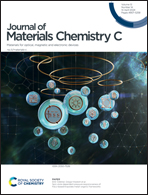Pb2Ga3F6(SeO3)2X3·2H2O (X = Cl, Br): two new HTO-type members exhibiting large NLO effects mediated by ionic mixing and substitution strategies†
Abstract
The anion mixing strategy and equivalent substitution of functional groups are two effective and controllable methods to improve the probability of obtaining noncentrosymmetric (NCS) structures and optimizing nonlinear optical (NLO) performance. Herein, Pb2Ga3F6(SeO3)2X3·2H2O (X = Cl and Br) are discovered via cation group substitution and introduction of oxyfluoride [GaF4O2] octahedra. They are also the first examples possessing two kinds of halogen atoms in the hexagonal tungsten oxide (HTO) family. Pb2Ga3F6(SeO3)2Cl3·2H2O and Pb2Ga3F6(SeO3)2Br3·2H2O are isostructural and crystalize in the noncentrosymmetric trigonal space group R32, and they feature a three dimensional (3D) framework with HTO-type [Ga3F6(SeO3)2]∞ layers linked by [Pb2Br3]∞ layers. Owing to the effective arrangement of chemical functional units, Pb2Ga3F6(SeO3)2X3·2H2O exhibit strong SHG responses of 4.0–4.5 × KH2PO4 (KDP) and short UV cut-off edges of <300 nm, which are two essential parameters for NLO practical applications. The other physical and chemical properties of title compounds were evaluated in this work using IR spectroscopy, thermal parameter measurements, and theoretical calculations.



 Please wait while we load your content...
Please wait while we load your content...